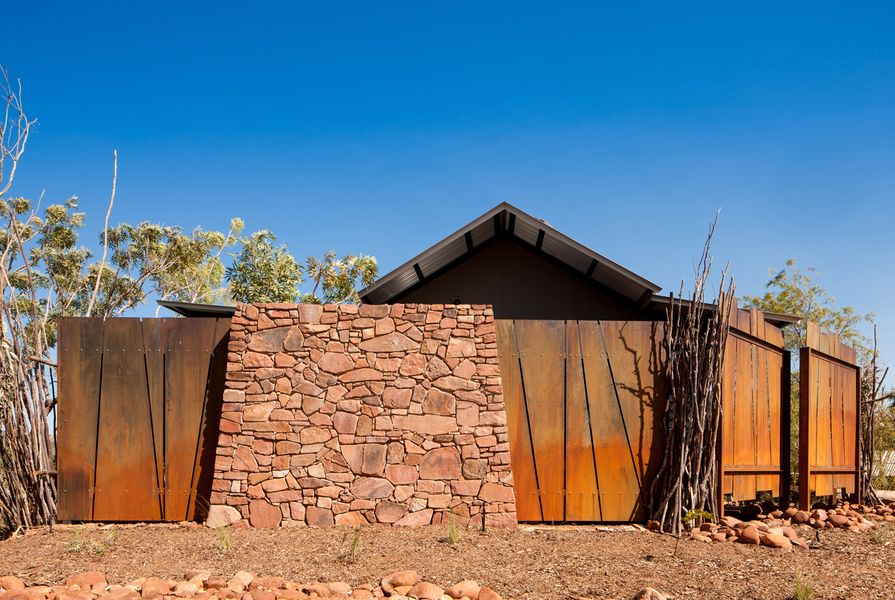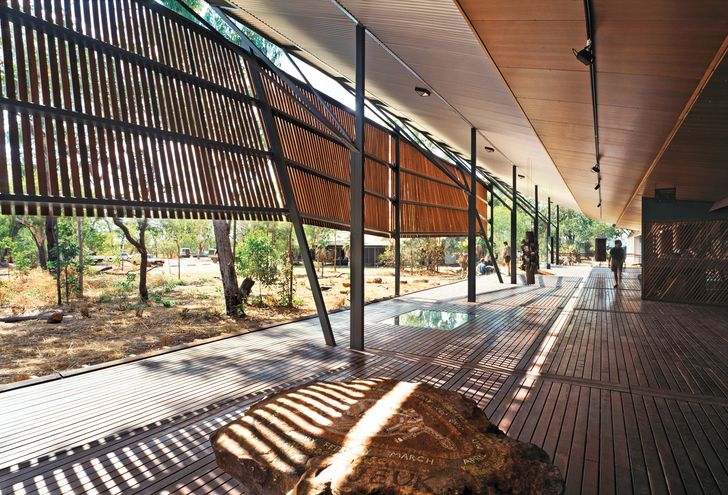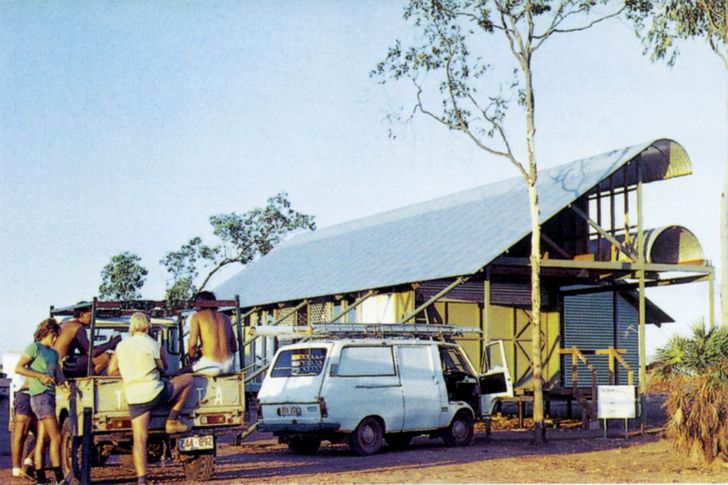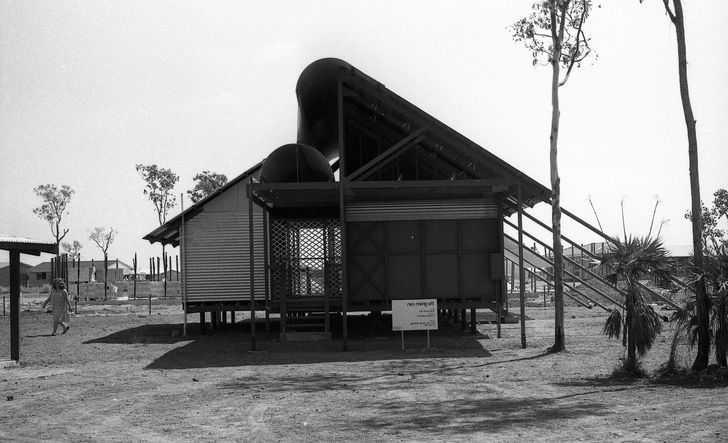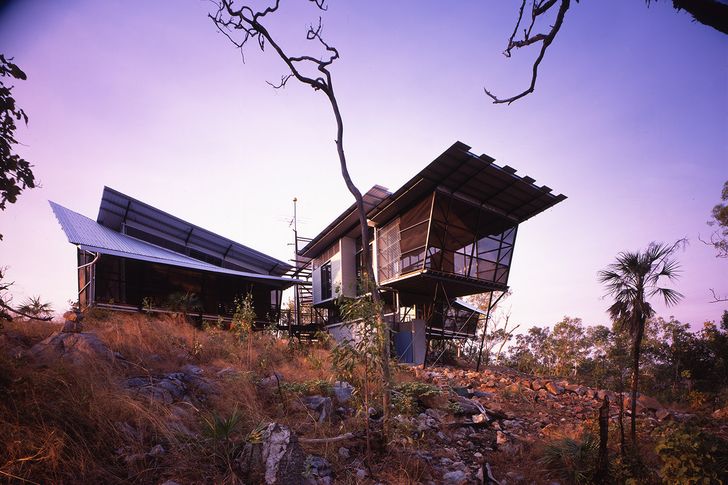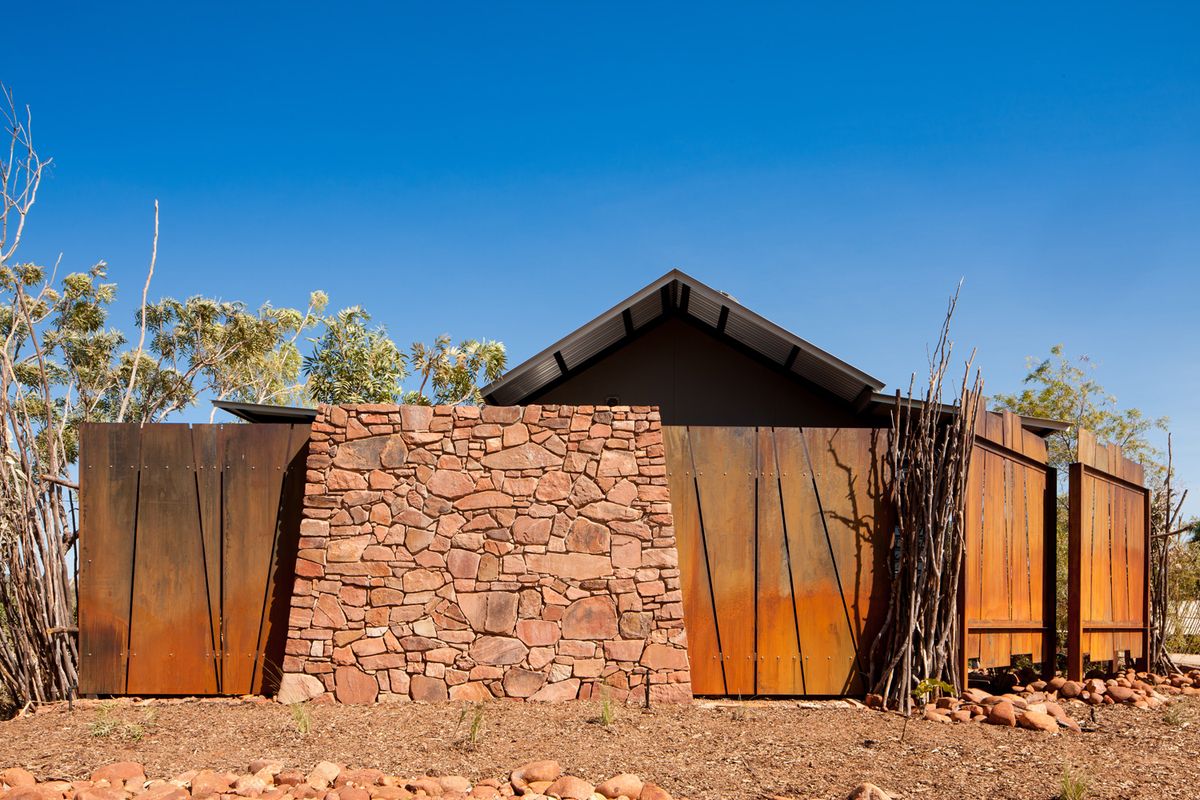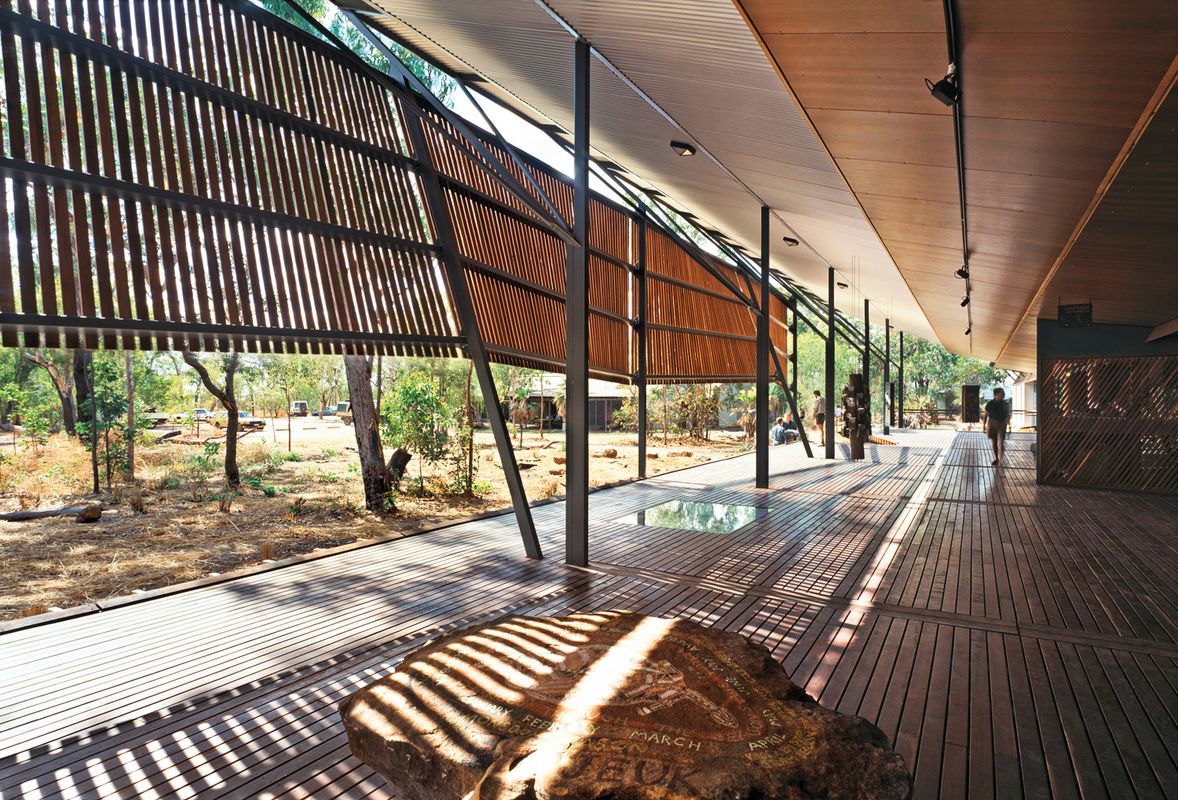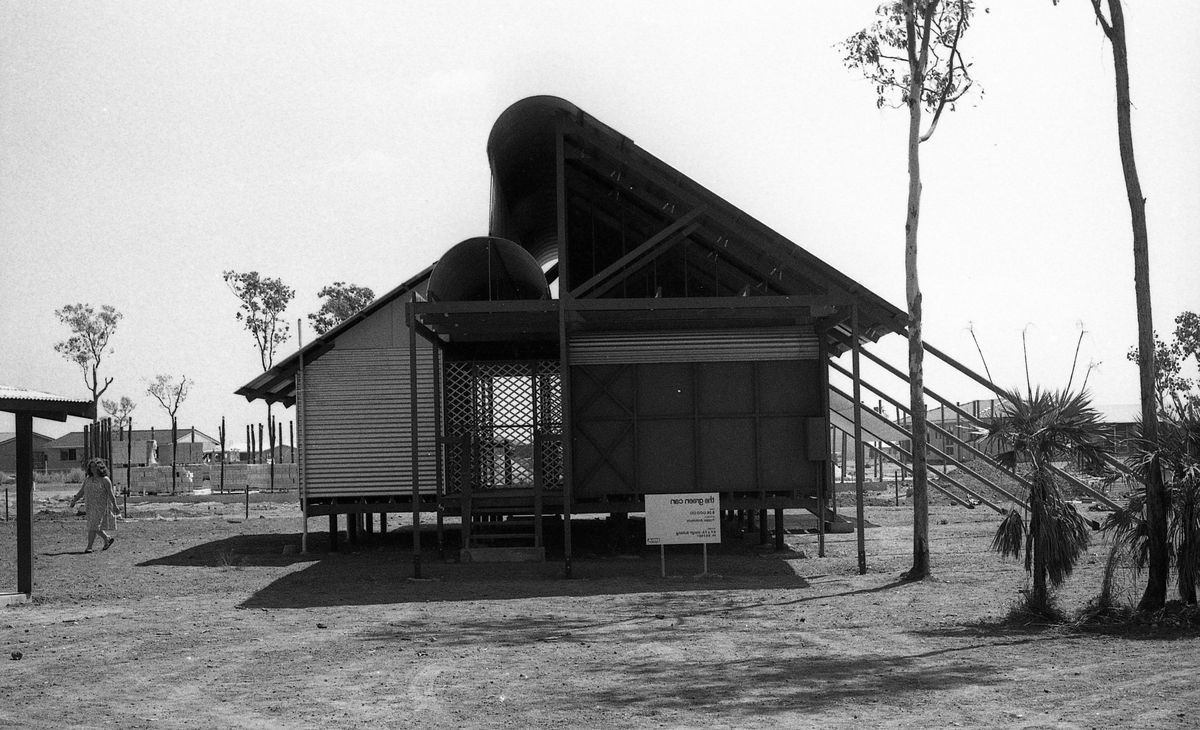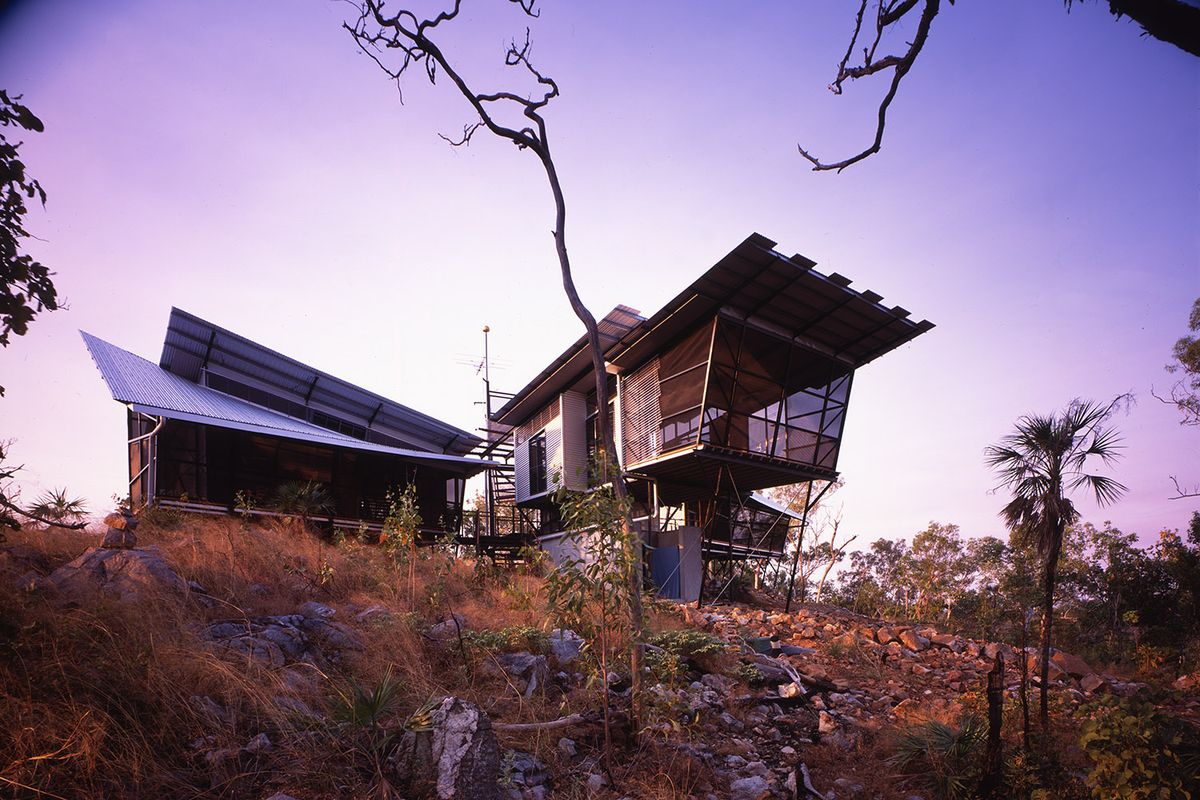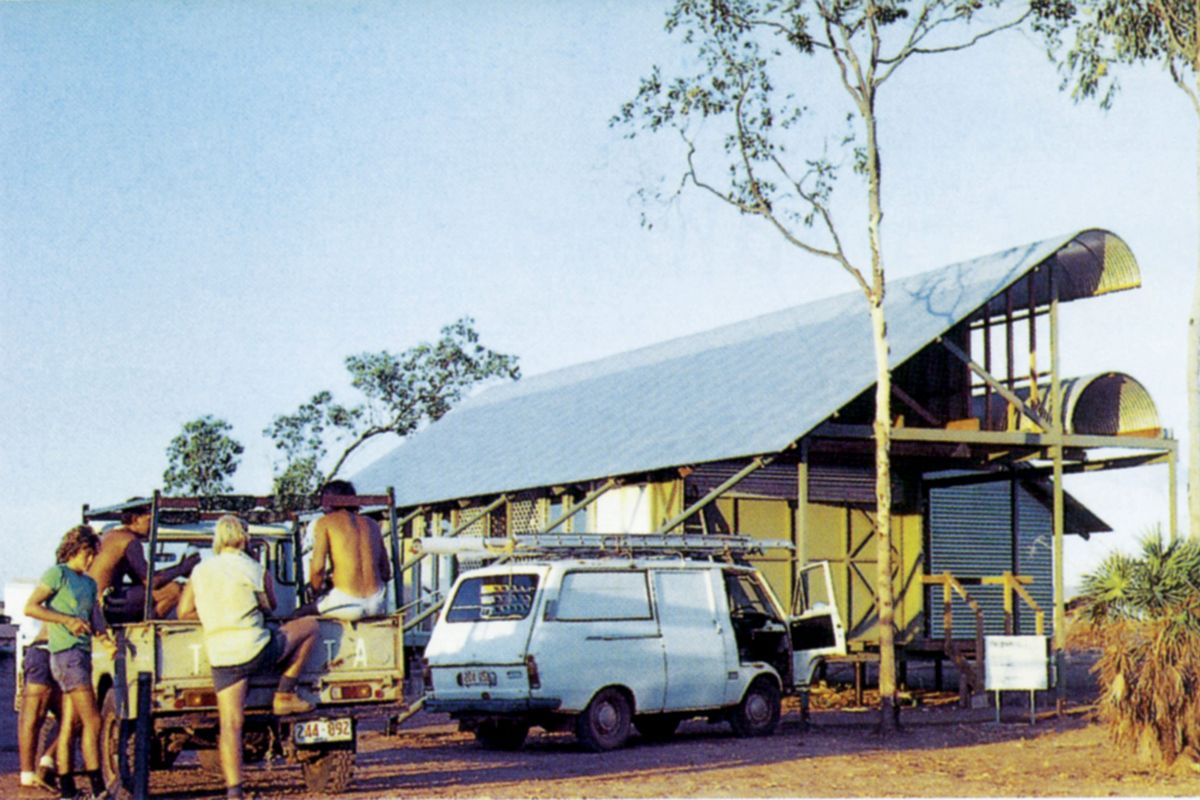
Adrian Welke and Phil Harris, co-founders of Troppo Architects.
Image: David Sievers
Because life is very much about passing the baton, we’ve entitled this address “From Me to You” after that old-school song by The Beatles. This talk, our finale, comes on the back of a tour of fourteen cities in Australia and Asia, where we have met bright-eyed and proud young architects, and dilettante fans of architecture. We’ve suffered long, fattening dinners and seemingly bottomless bottles of wine, often with many old friends and mentors. In each place we’ve spun a yarn about the Troppo journey entitled “Troppo: 35 Years of Going Backwards.”
That talk began with our student trip around Australia and the publishing of Influences in Regional Architecture (with our fellow travellers, Justin Hill and James Hayter)1. It toured the history of top end housing – an investigation that gave birth to our practice – and strolled through Punkahs and Pith Helmets: Good Principles of Tropical House Design2, which detailed what we learnt from that study. It moved from our ponderings about how simple a dwelling could be, to the mystery and magic of the “theory of the tenth line”3 and the notion of “architecture by accident”4. We explained how we are but two of five directors and two of many, many people who have given Troppo life. We raised our glasses to the thousand or so punters who claim we’ve brought them happiness over the past thirty-five years.5 It was all copiously illustrated by projects: from the early ones in Darwin to others in weird and wonderful places, from glamorous beach locales to things more urban or ridiculously remote.
Through our work, we saw black and white Australia (and yes, we mean that, because it seems increasingly that we’re creating our own double standards in this country). We mused on a new town for Darwin, where, down the main street, we might still have grass fires to celebrate the dry season, and walk in the shade to the pub to look out over a retained wetland that filters site water run-off to a pristine creek. There were structures that were like sea creatures, outrigger canoes, swishing fish and eagles. There were simple structures, and structures for blokes whose military initiation requires them to stop ceiling fans with their heads. And there was one illegal structure (at least, one that we’re owning up to).
Bowali Visitors Information Centre in association with Glenn Murcutt, Kakadu National Park, NT, 1992–94.
Image: John Gollings
We spoke about the process of making. And we spoke about feeling the Country. There were drinking slides and even a poem, because the poem is like an anthem to remind us that we are but little dots in the passage of time and the way of nature. And that is what we banged on about on the tour.
Today, however, it behoves us to reflect on what the Troppo journey, lit from the side by our friends, might have taught us. As always, we begin with history. This address is named in honour of Alfred Samuel Hook, who, it seems to us, was a good bloke whose ambitions were selfless, noble, egalitarian and socially and professionally important. Born in England, Hook worked in Cairns and Brisbane before joining the government architect’s office in Sydney and contributing to the foundation and curriculum of the Faculty of Architecture at the University of Sydney. Appointed associate professor of architectural practice and construction in 1926, he was “the practical man” of the faculty, highly regarded in structural mechanics.6 Through his involvement with the Architects’ Association of New South Wales, he sought to improve architects’ salaries and working conditions. He was also a founder of the National Royal Australian Institute of Architects, its inaugural president in 1929, and its first life-fellow.
At the time of Hook’s death in Randwick in 1963, The Beatles topped the British charts for the first time with a song entitled From Me to You; Phil’s first car was rolling off Ford Australia’s new production line; and Adrian, aged eight, was catching the school bus on the sandy plains of the recently cleared Esperance wheat-belt. Roy Grounds was still working on the NGV in Melbourne; Robin Boyd’s work was first being published around the globe; Rick Leplastrier was about to get a gig working with Jorn Utzon, as the Sydney Opera House documentation ground on; Glenn Murcutt, two years out of university, was off drawing courtyards of houses in Mykonos, Greece; and in Queensland, Jim Birrell, who has nurtured so many of our Queensland architectural friends’ careers, was still three years away from private practice. Australian architecture was on the runway, ready to fly. Hooky had set us up well.
So what in this great man’s career resonates for us? Firstly, we love that he saw that architecture was firmly of the arts, but that there had to be technical excellence in construction. He was artistic, yes, but foremost a “nuts and bolts” man. Indeed, we concur: architecture is about building, knowing your materials and learning how to put them together – efficiently, durably and sweetly. Otherwise, we’re left with set design.
We also love that he had a social conscience and was an egalitarian. He was about taking architecture to all classes, and he pushed that the practice of architecture should be undertaken by men and by women. He could also see that we had to learn well, not just within the context of the arts, and to acquire our technical skills, but also to be aware of the politics of building.
Green Can, Karama, Darwin, NT, 1982.
Image: Courtesy Troppo Architects
It seems, be it because of time and place or the lack of an existing academic field, that Hook had a very pragmatic feeling for architectural education – that it should exist for a directed, civic purpose. Our view, too, is that architectural education should not be left to academics. Every maturing architect must mentor undergraduates and graduates to accelerate their understanding of the profession – as a people-based profession, and one demanding of hard-won technical skills. We must get young, would-be architects into the cut and thrust of working with community and users, to understand the ways and skills of builders and trades, to see one’s drawings emerge on site, to make and recover from mistakes. This would be an education about things technical, in a social context and with practical experience in art and artifice.
Hook began his career in the tropical “bush port” of Cairns before heading to a regional capital and finally the big smoke. We think he would agree with our proposition that we must also get students and young architects out into Country, into regional, outback and Aboriginal Australia, where their education might also be about environmental awareness, the natural diversity of this continent and the great connectedness of things within it. It would also be about the resourcefulness of our extraordinarily adaptive farmers and pastoralists and, most importantly, it would be illuminated by the ancient ecological wisdom and deep, place-centred spirituality of its first people. We don’t think architectural education is much about imagining fantastical futures. We think Hook was too well grounded to think that, too.
Now we turn to the politics of practice, and the notion that architects are influencers. Ultimately, the practice of architecture is an action about “now.” Accordingly, and unavoidably, the decisions we make within practice will amount to a political statement. Well then, we had better have noble values, with the health of the planet and society at the forefront of our thinking!
To start with, architects have the opportunity to make – rather than take – a brief, to devise a rich program around the often-trite initial aims of a project. Every program must be developed with an “ecological” view – one that is not only mindful of fit with physical context, but also thoughtful about energy and resource impacts. Thinking ecologically means we must also consider the social opportunities for a community to grow by its involvement, if not in construction, then in its eventual use – perhaps through the gesture of the street seat, the spacious street verandah, the integration of art or ground-plane activity through commerce. Such an architectural program stands a good chance of becoming interpretive, embedding stories of place in the material selections, the micro-climatic response, the architectural devices and, of course, in the art. Architecture has always been about “process,” a set of activities around making, involving people. With time, this design and making process has become increasingly and wonderfully more complex, through our social awareness, the specialization of design disciplines and new technologies, materials and systems.
Green Can, Karama, Darwin, NT, 1982.
Image: Courtesy Troppo Architects
We’d be totally blinkered if we didn’t think our task must be collaborative with community and users, as well as designers, artists, specialist engineers, trades and suppliers. Collaboration is spontaneous and requires informality, intimacy and passion. It cannot be predetermined. It cannot be managed from outside, by a pre-organized methodology. Yet this is what is happening! Project management has become the emperor in the world of making. In projects of any scope, and increasingly those at the smaller end, it struts out there, calling the tune from the position in which architects once stood. Well, let’s call it: The emperor has no clothes! Allow us to explain …

Owner-built Phillips House, Howard Springs, NT, 1984.
Image: Courtesy Troppo Architects
As practising architects, in the 1980s we had quality assurance thrust upon us. But, by definition, that’s what we already did! Our skill and application became obfuscated, shifted away from design, project detailing and collaborating and replaced by form filling-out. Then, we were “gifted” the invention of project management – again, something we already did! These project managers from business or engineering school established for themselves a position like guards at the confluence of people and place, coming between users and creators to ridiculously diminish opportunities for collaboration, all the while giving us more boxes to tick. Divide and conquer. Under this regime, the procurement methodology for much government-sponsored work is akin to using a sledgehammer to crack a nut – from the start, we have forgotten what the nut was. It seems that only practices with an actuary’s mind are able to win through these procurement matrices of impersonality, yet so often the nut is crying out for personal passion, continuity and commitment. This is nowhere more evident and tragic than in regard to the “hard nut” that is our proudly remnant, and proudly strengthening, Aboriginal Australia.
Architects have always offered commitment – it’s instilled into us from the student beginnings, where nothing short of a string of all-nighters will do. Our work becomes our baby, our clients become our friends, and our professional generosity is often to our financial detriment. We’ll go out on a limb to devise a strategy around the forest of guidelines and regulations, as deviously as need be, to get common sense into built solutions. On the other hand, project management and corporate professionals are in it for return and another line on the CV. There’s no room in this “tent” of rarefied management-speak for architects that can only show human and project empathy and a “fire in the belly” to forge a difference. And the community – at both the user and the taxpayer ends – suffers the mediocrity of dispassionate, unsurprising delivery, while the fees fatten at the top and the matrices and audits fill up forever greater volumes of evenly tempered gobbledegook. If we’re not careful, an architect’s political skill, passion and tenacity will wither and that precious fire in the belly will splutter to a smoulder. We don’t think Hook, musician, architect and man of spontaneity, would approve of this situation.

PeeWee’s at the Point, East Point, Darwin, NT, 1998.
Image: Patrick Bingham-Hall
Allow us now to get onto “making,” to explain why we love to participate spontaneously and richly in it. Making is about head, hands and heart. Inseparable from rich and purposeful creativity, together they also explain our humanity. The head is calculating; our slippery, lateral mind; our memory. It is plugged into our inherited knowledge and traditions, and it brings a science to our making. Our hands take us to surprising places: when we pick up a musical instrument, a tool or a pen, there’s no knowing where it will end. It’s the hand that creates art. But without a heart that has feeling, that is noble, caring and socially considerate, we will not proceed with good purpose. A heart that can feel the spirit of place and moment, and sense and fill with the possible, and give of its all … that heart will really take us somewhere.
Making needs all these things. It is a human thing – a people thing. But people are naught without a planet that sustains them. And the planet is not a dumb ball of stardust: it’s an intricate web of life in strange and myriad form. It is elements: earth, air, fire, water. It has power: it turns evenly yet unpredictably, and at times it seems to turn on us – destroying then renewing and nourishing us. We cannot separate our wellbeing from it. As Big Bill Neidjie said in his poem, “Feeling”:
Tree smooth
What about you’n’me smooth skin?
Might be sunburn you, but you got white, no-matter me.
But this the story. You can’t split im,
You can’t change im, you can’t do anything.
This story you got to keep im … in your feeling.
Tree for us, eagle … anything.
Eagle, bird, animal, rock … this the story.
Listen carefully, careful
And this spirit e come in your feeling
And you will feel it… Anyone that.
I feel it … My body same as you.
I telling you this because the land for us,
Never change round, never change.
Places for us, earth for us,
Star, moon, tree, animal,
No-matter what sort of a animal, bird or snake…
All that animal same like us. Our friend that.
This story e can listen careful
And how you want to feel on your feeling.
This story e coming through you body,
E go right down foot and head, fingernail and blood.
Through the heart.
And e can feel it because e’ll come right through.
And when you sleep you might dream something.
In this material world, it’s hard to believe we’re of the same background as so many in the so-called “less fortunate” world, even of the same blood as our forebears. How little our parents and grandparents lived with, how little so many people on this planet still live with. How little all people once lived with. Now, it seems the climate is an enemy to be tamed: we must air condition our homes and workplaces, and we pat ourselves on the back for tackling greenhouse gas emissions with approval frameworks that are predicated on the inclusion of energy-heavy air-conditioning. A sealed, insulated box – an esky – becomes the ultimate energy efficient building paradigm. Come on… the emperor’s turned up in the nude again!
As a rule, our free-running tropical buildings, regionally proud, built on tradition and with the lowest imaginable energy inputs, in fact receive 0 of a maximum 10 stars – even when they win sustainable architecture awards. Sure, flood, cyclones, drought and fire colour our impression of the difficulties of this country. But in most parts of Australia, it’s gorgeous 300 days of the year – and a memorable, socially binding “talking point” for the rest. Throw away the so-called energy efficiency provisions of the building code and bring back intuitive design that is based on understanding what has worked in the past. Pay a serious penalty to add air-conditioning, and give credit to buildings that operate well 300 days a year without air-conditioning. As Max Pritchard once told students in the temperate south, “if you’re cold, put on a jumper!” Perhaps up north, it’s “get out a beer!” This approach to making architecture that we argue for is people-centred and intuitive; it is humble in its interdependency with nature, bound by place and acutely aware of inputs and outputs.
Rozak House, Lake Bennett, NT, 2001.
Image: Patrick Bingham-Hall
And what of “shelter,” architecture’s core purpose? Food, sex and shelter are the three things that all creatures need. But what is shelter? At Troppo, we say it’s not an artefact, it’s not a material thing, nor about property value, style or decoration. Controversially perhaps, we think it isn’t much to do with that inert lump called a building! Shelter proffers the same ideal for all creatures. We don’t always shelter from things, we also shelter to be able to better interact with our surroundings. Think of an eagle, perched away from its nest awaiting the moment to dive to kill, or a fish parked in sea-grasses, awaiting the passing of a new tide’s nourishments. Can good shelter be a sealed, bubble-like box? Locked away, disconnected from our environment, how can we hope to be wise to all of the social opportunities around us? How can we appreciate the intricacy of the planet that sustains us? Architecture that understands shelter as a basic dynamic in our lives goes beyond the tangible building. Such architecture extends our environmental connection and our social opportunity. It holds, reflects on and perhaps even projects our stories. In fact, for our planet’s and its diverse societies’ sake, it must. These are things that development plans and building codes should state on page one. If those things are delivered, what else matters?
So it is that we make, mindfully and with gusto, but always remembering our place and purpose in this great and powerful natural world. In this older world of predecessors that have been generous to us, and in the emerging world of our children’s children, who though perhaps unknown are already ours to care for. And so it is that we make humbly …
Ngalyod
Rainbow serpent, serpent spirit,
Generative yet consuming,
Power of creation and of destruction.You emerge:
Sun turns to cloud to storm, then
The careening flood
That writhes, swathes, renews.
You recede: Scarring, making, marking this country.You dwell: We hear you in the tumble of the waterfall,
Feel you, restless, in river depths.
You have to rise:
To twist and arch skyward again,
The great cycle, giving, taking.Aware of you
We stand here, surely, honoured,
Knowing we are connected with the infinite.
Cheers!
Adrian Welke and Phil Harris are the 2014 Gold Medallists and the co-founders of Troppo Architects. This essay is an edit of their AS Hook Address, given at Christ Church Cathedral, Darwin, 7 November 2014.
1. Influences in Regional Architecture, Welke, Hill, Hayter& Harris, Adelaide 1978
2. Punkahs & Pith Helmets: Good Principles of Tropical House Design, Harris & Welke, Darwin 1981
3. The theory of the tenth line: an image of a cube has nine lines, drawing in the tenth line “explodes” the cube to create an image of a frame. And from there, one can create an architecture where just enough is added within the frame to “do the job.”
4. Architecture by accident: the “funnest” bits of architecture are often the unpredictable patterns and special connections that come from conjoining space and layers in architectural fabric, perhaps from elements that play with light and shadow, or filigrees overlaid. It’s a bit like making a cake: bang in the right ingredients (with a little knowledge and feeling), and something’s going to happen – inevitably much more than one can predict.
5. Troppo contributors are: Dean Adams, Vanessa Amodeo, Alex Ashley-Jones, Cathy Baily, Ric Bell, Joanna Best, Simon Brown, Victor Cai, Wendy Christie, Geoff Clark, Dan Connolly, Lucy Crawford, Mary Crosdale, Dan Devine, Brent Dowsett, Cary Duffield, Stuart Dunsford, Shaneen Fantin, Edward Farinha, Anna Faunt, Bec Francis, Jamie Gill, Jeremy Gryst, Damien Guerin, Jane Hilliard, Sue Harper, Maddie Harris, Sue Hastwell, Dave Henderson, Kirsty Hewitt, Hannah Hiscock-Croft, Fiona Hogg, Ryan Horsnell, Glenn Howe, Madeleine Hug, Dana Hutchinson, Ebony James, Wendy James, Andrew Kerr, Linda John, Aftab Khamisa, Nita Kidd, Richard Layton, Manuel Liveris, Nick Lymn, Alison Mcfadyen, Greg McNamara, Chantal Marks, Christine Mifsud, Matt Minarelli, Katy Moir, Darren Moody, Peter Muskens, Giles Newstead, Greg Norman, Andrew O’loughlln, Bridie O’toole, Terry O’toole, Jenny Patterson, Tain Patterson, Susan Powell, Joanna Rees, Kelley-Joe Rochow, Lynn Rorich, David Rutter, Peter Savage, Alison Shepherd, Frangiska Skiadis, Jason Skinner, Kerri-Ellen Stallard, Brad Steinert, Don Stellard, Jason Southam, Amy Sullivan, Zammi Rohan, Peter Tonkin, Justin Twohill, Emily Van Eyk, Melissa Walker, Carole Walls, Julius Welke, Michael Wells, Hugh Wilkinson, Richard Wilkinson, Carly Williams, Lena Yali, Danny Zalishansky.
6. ‘Hook, Alfred Samuel (1886–1963)’ in Australian Dictionary of Biography, Vol 14, MUP, R. Broomham, 1996

